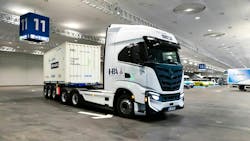DOE Releases Plan for Electric Freight Truck EV Charging Corridor
The Department of Energy’s Joint Office of Energy and Transportation released a strategy it calls the National Zero-Emission Freight Corridor.
Released jointly with the Department of Transportation and the Environmental Protection Agency, this strategy intends to deploy charging station infrastructure to support medium and heavy-duty shipping using electric trucks.
“The strategy is designed to meet growing market demands by targeting public investment to amplify private sector momentum, focus utility and regulatory energy planning, align industry activity, and improve air quality in local communities heavily impacted by diesel emissions,” according to a release from the DOE.
The strategy also includes hydrogen-powered vehicles. The federal government has set goals to reach at least 30 percent ZE-MHDV sales by 2030 and 100 percent sales by 2040.
A key facet of the strategy is meeting freight truck and technology markets where they are today, determining where they are likely to develop next, and setting goals to achieve decarbonization with transportation electrification.
The strategy designates highways and other important roadways as parts of the National EV Freight Corridor.
Phases of the strategy include:
- Establishing priority hubs based on freight volumes (2024-2027)
- Connecting hubs along critical freight corridors (2027-2030)
- Expanding corridor connections initiating network development (2030-2035)
- Achieving national network by linking regional corridors for ubiquitous access (2035-2040)
About the Author
Jeff Postelwait
Managing Editor
Jeff Postelwait is a writer and editor with a background in newspapers and online editing who has been writing about the electric utility industry since 2008. Jeff is senior editor for T&D World magazine and sits on the advisory board of the T&D World Conference and Exhibition. Utility Products, Power Engineering, Powergrid International and Electric Light & Power are some of the other publications in which Jeff's work has been featured. Jeff received his degree in journalism news editing from Oklahoma State University and currently operates out of Oregon.
